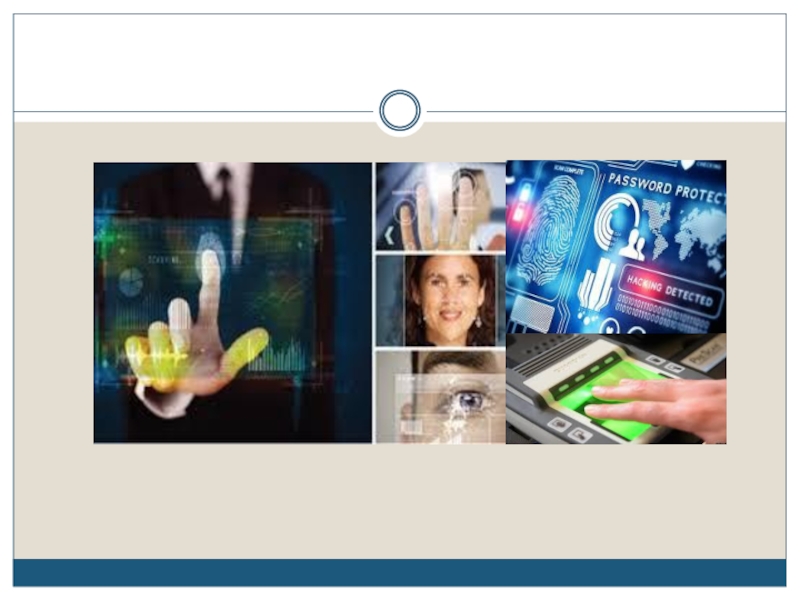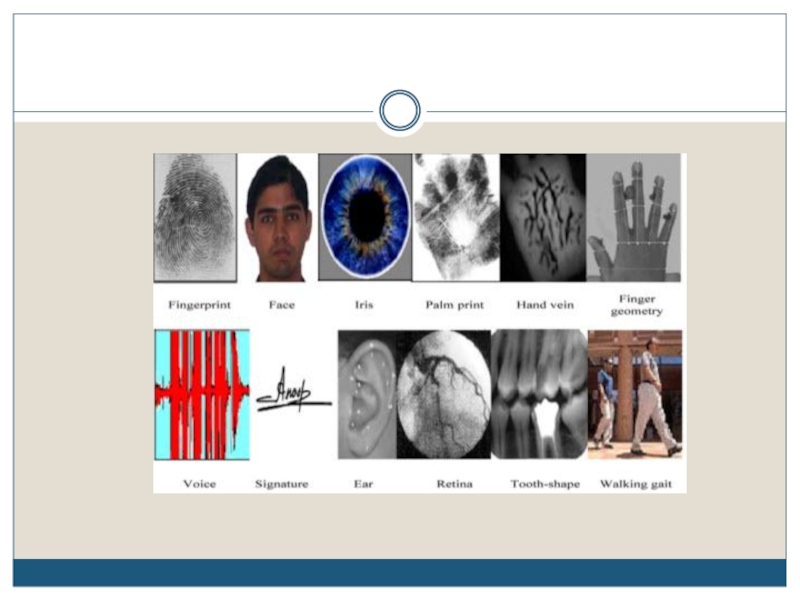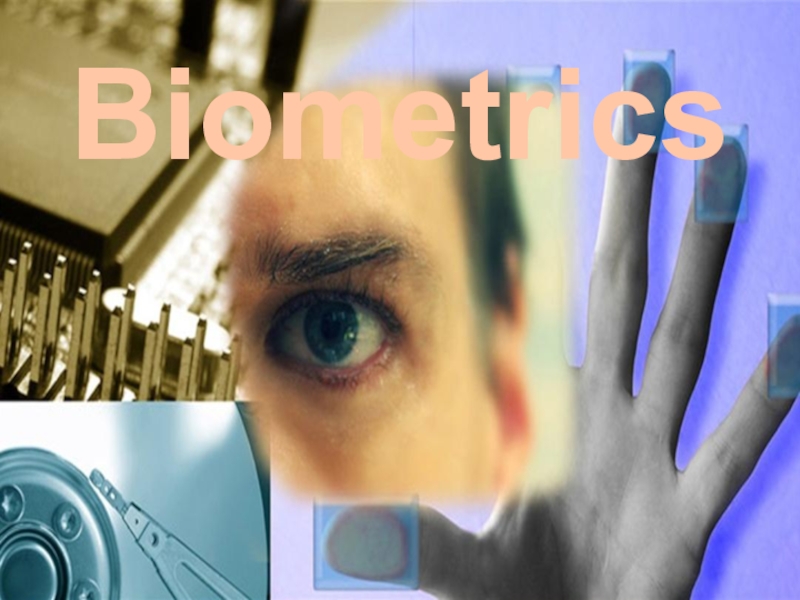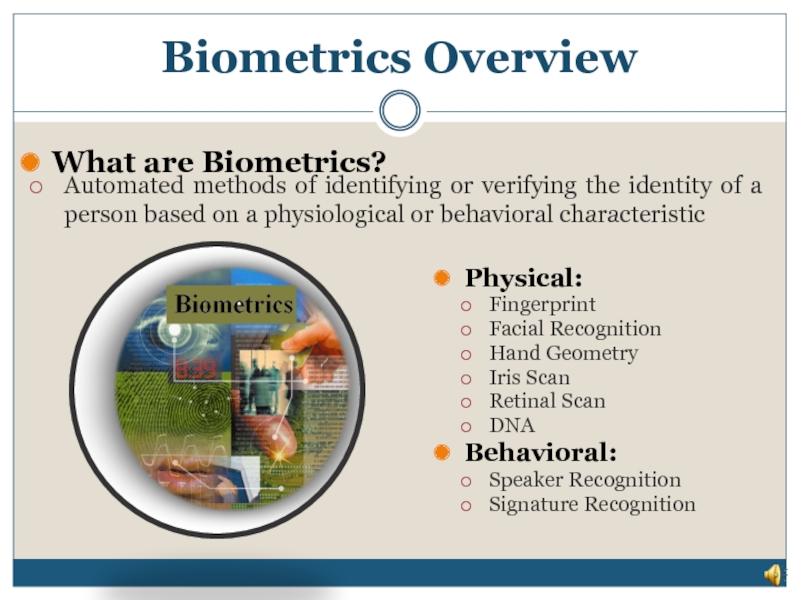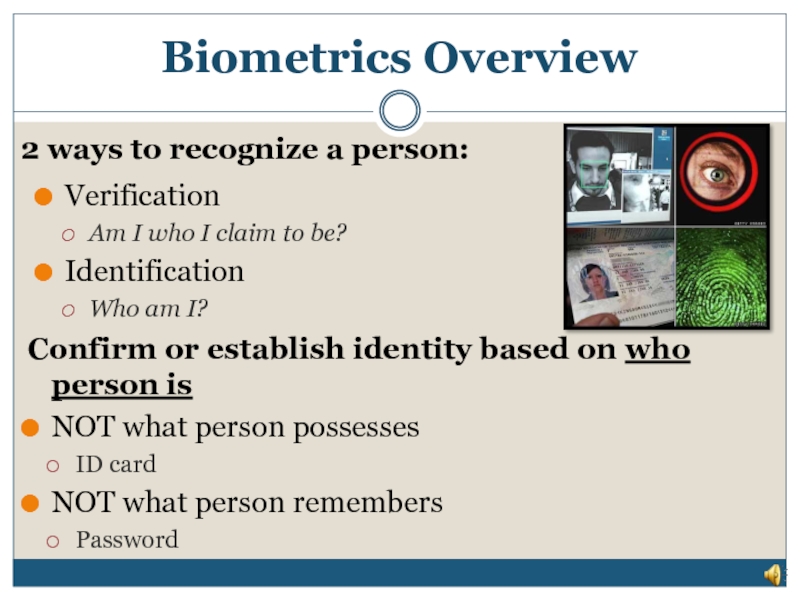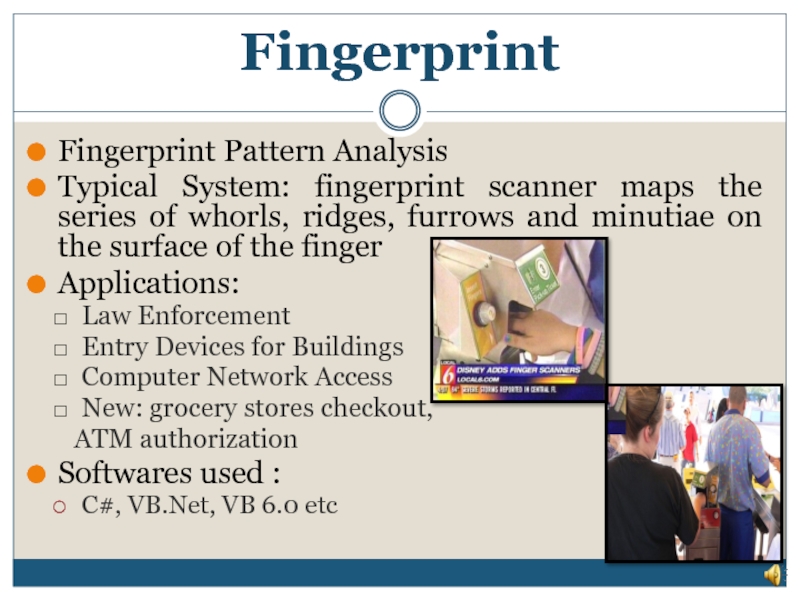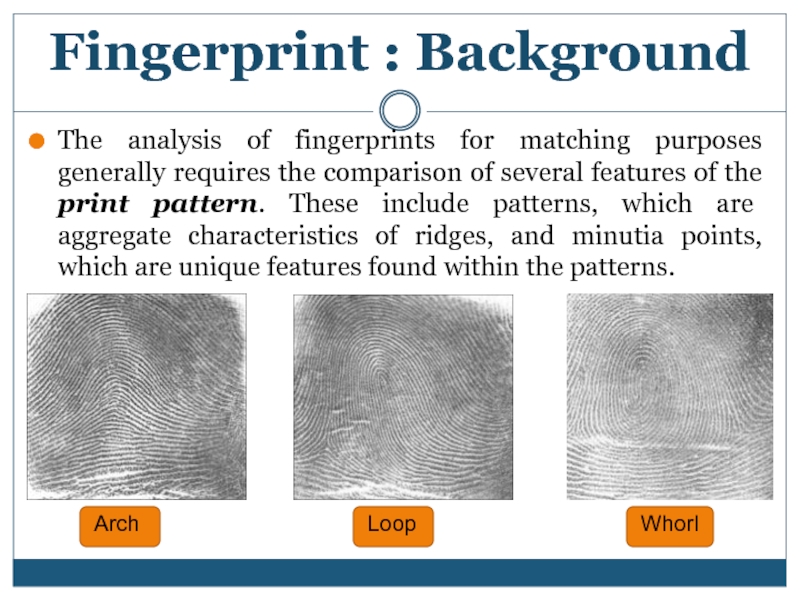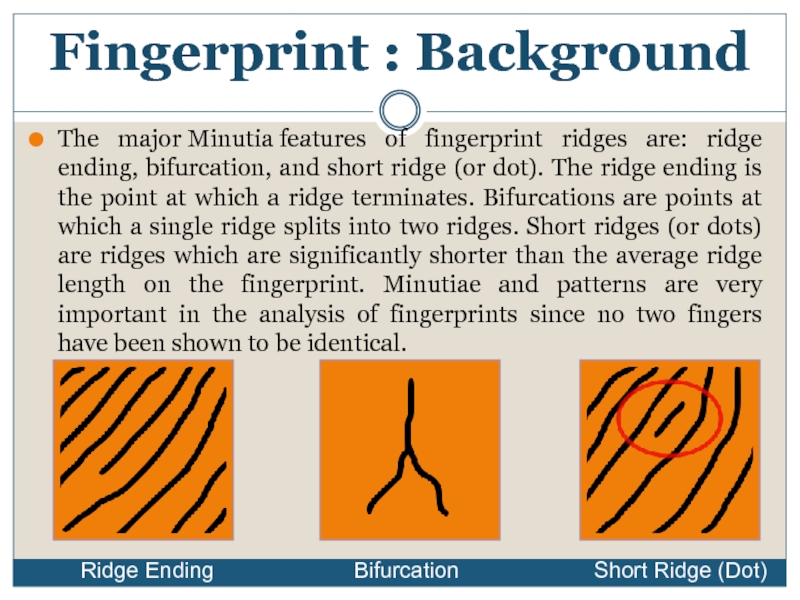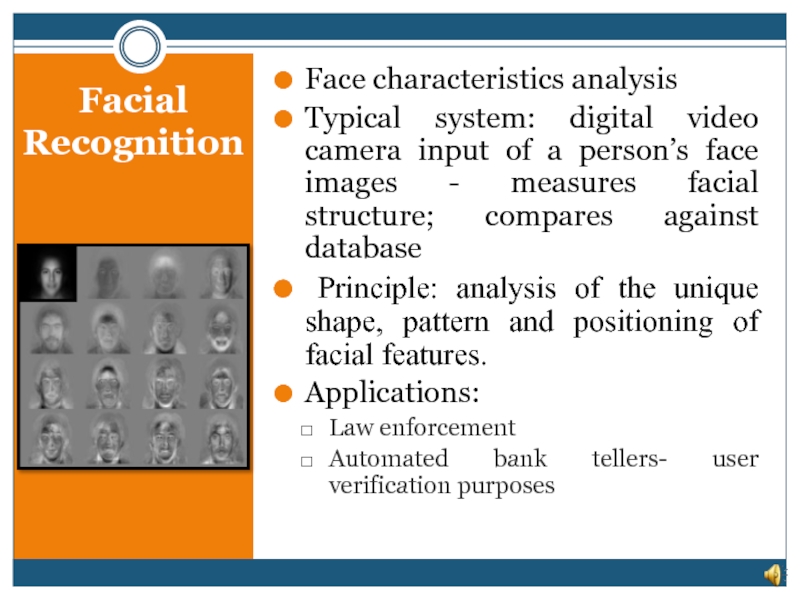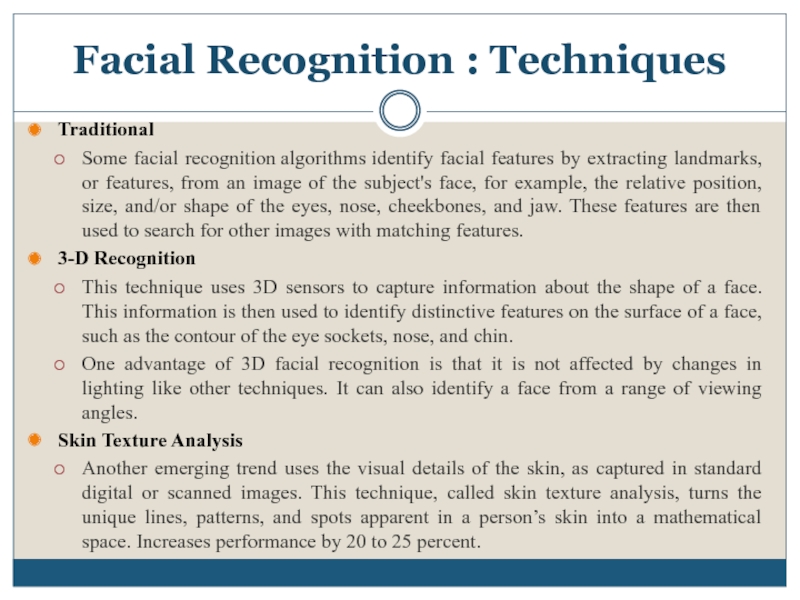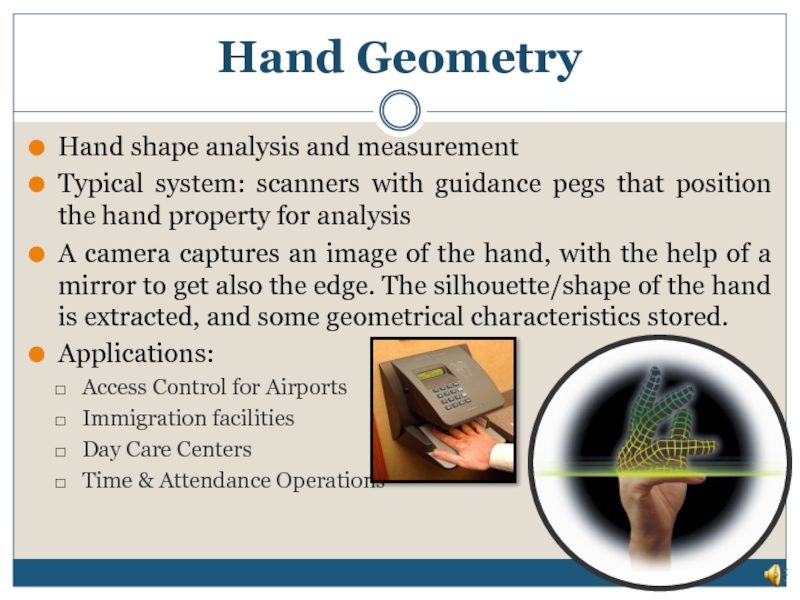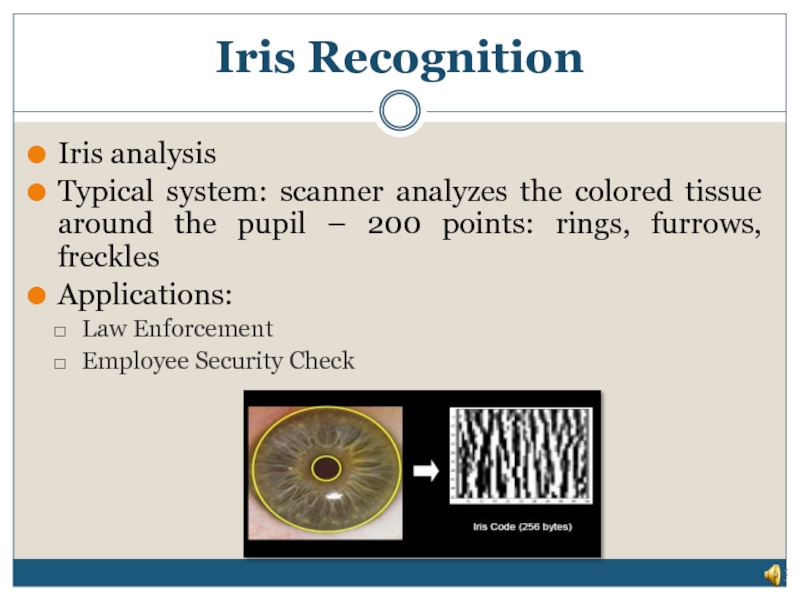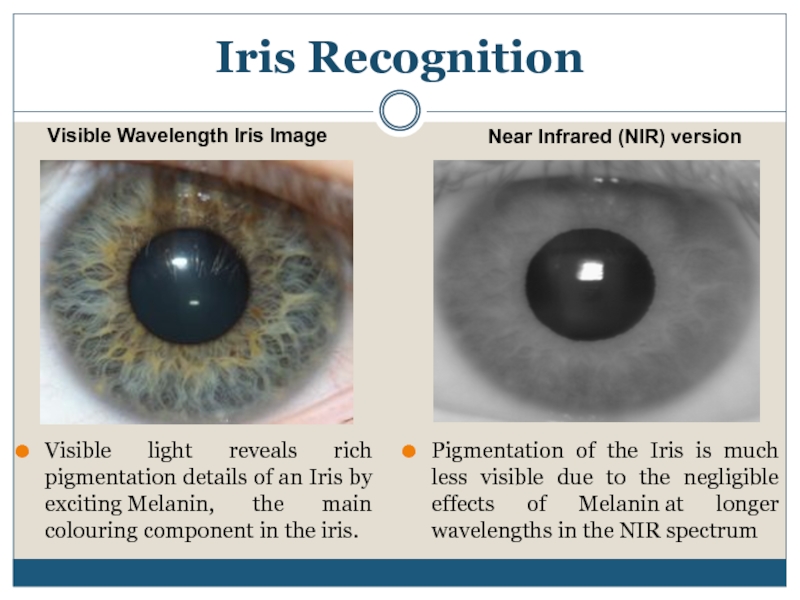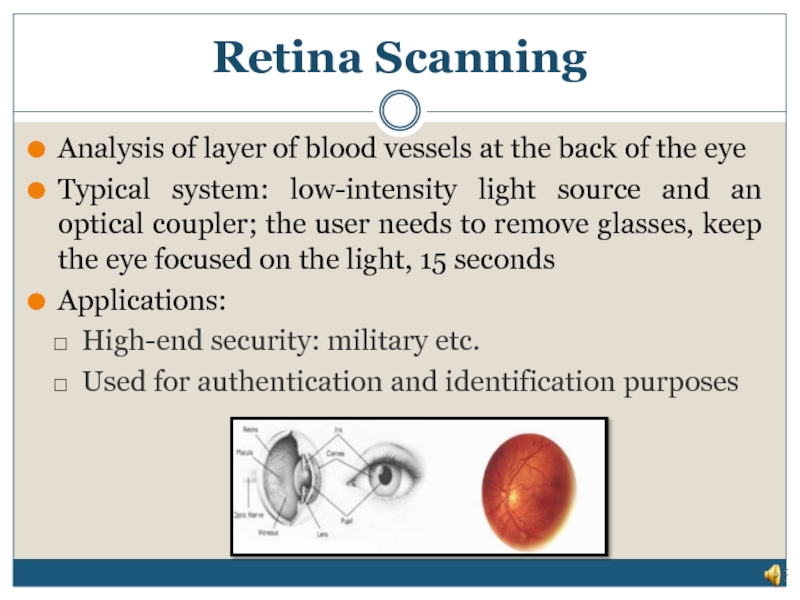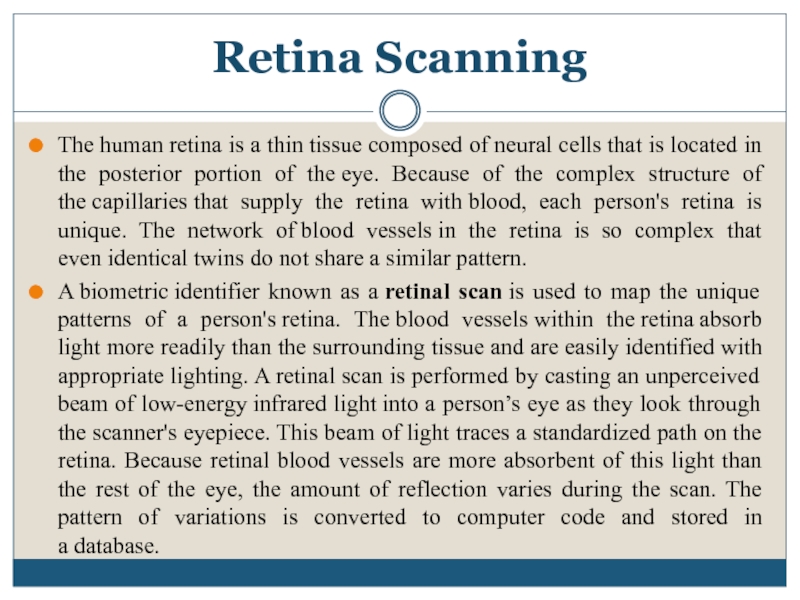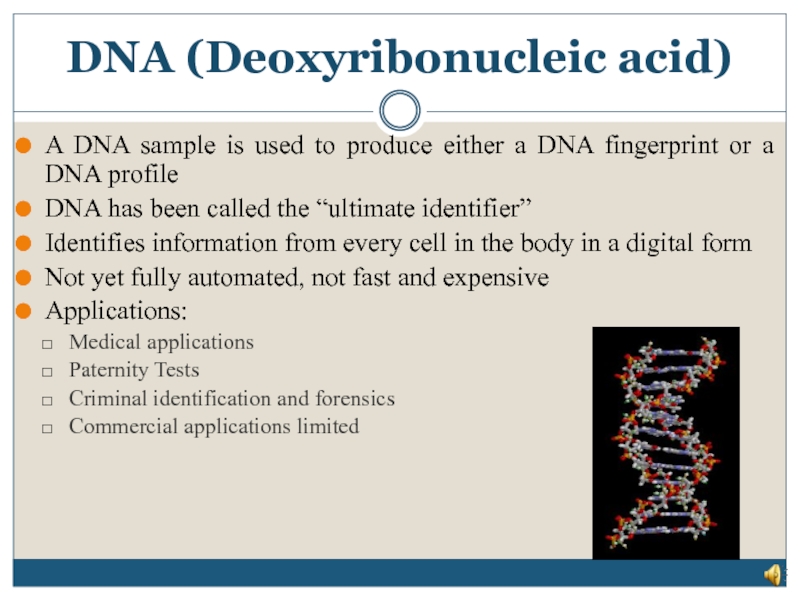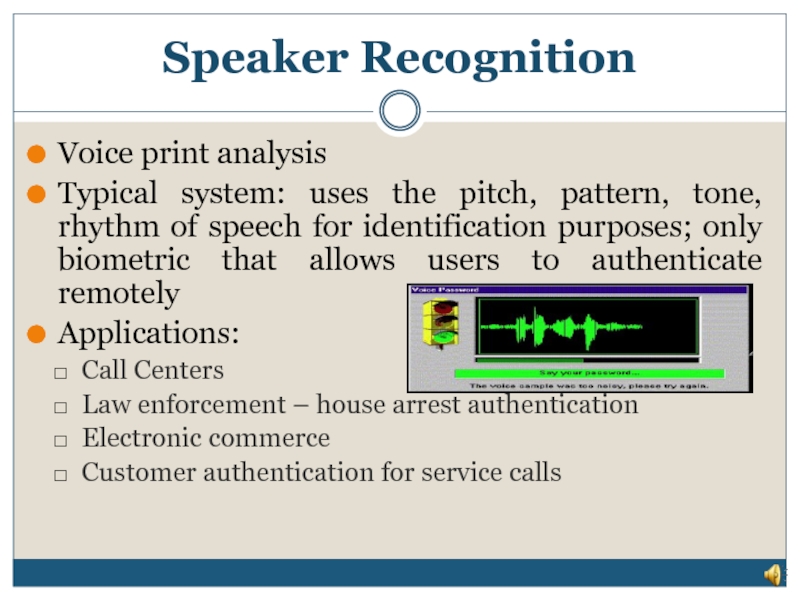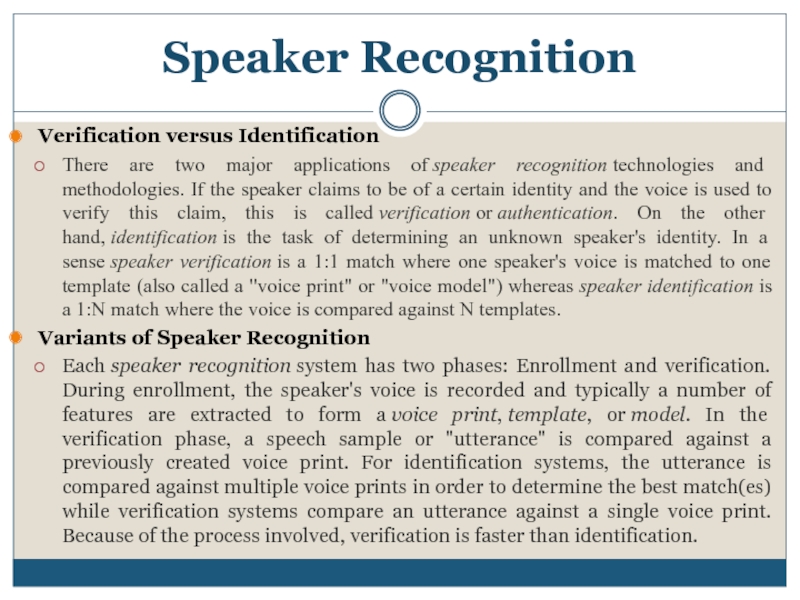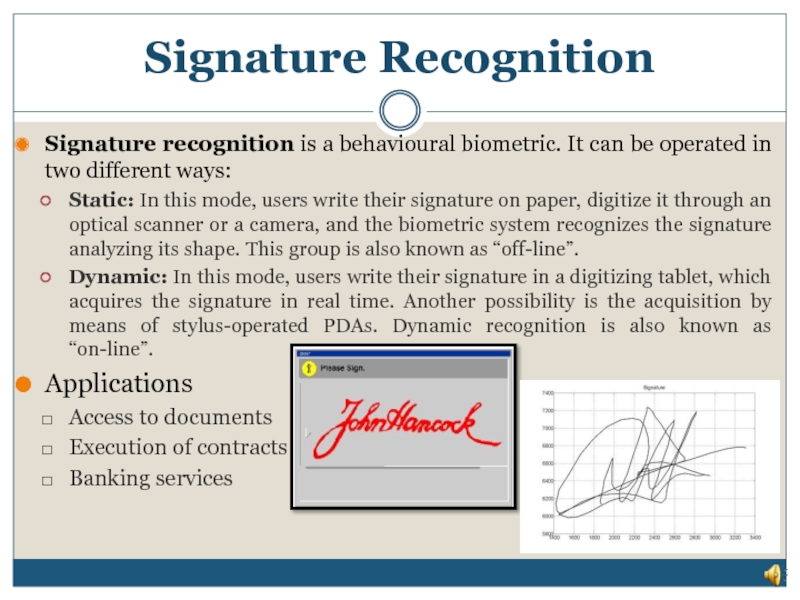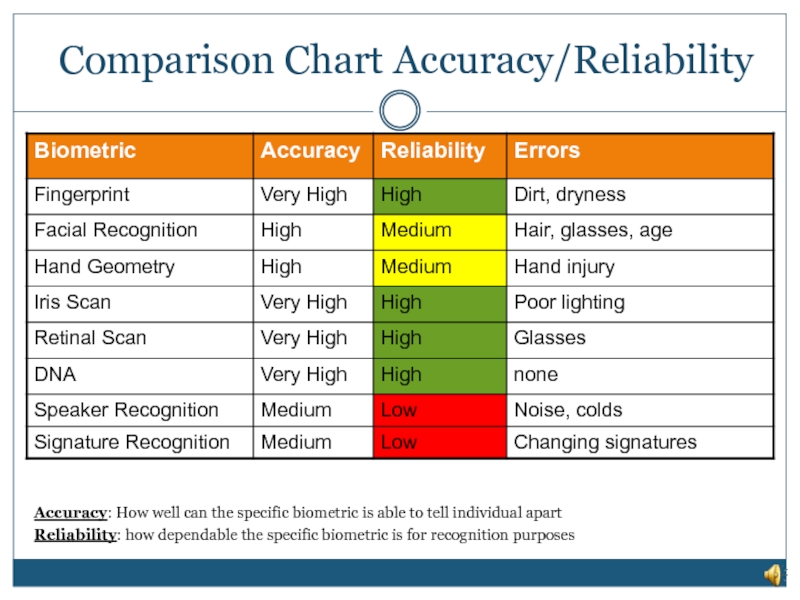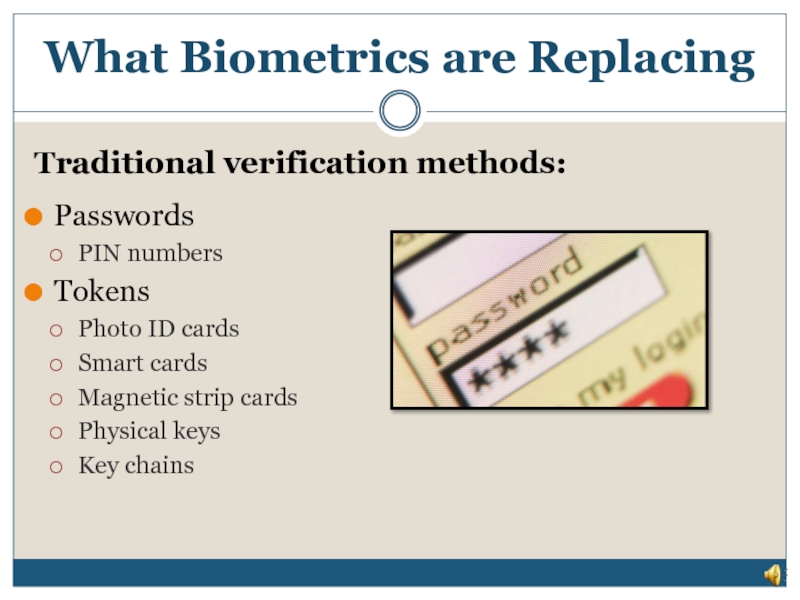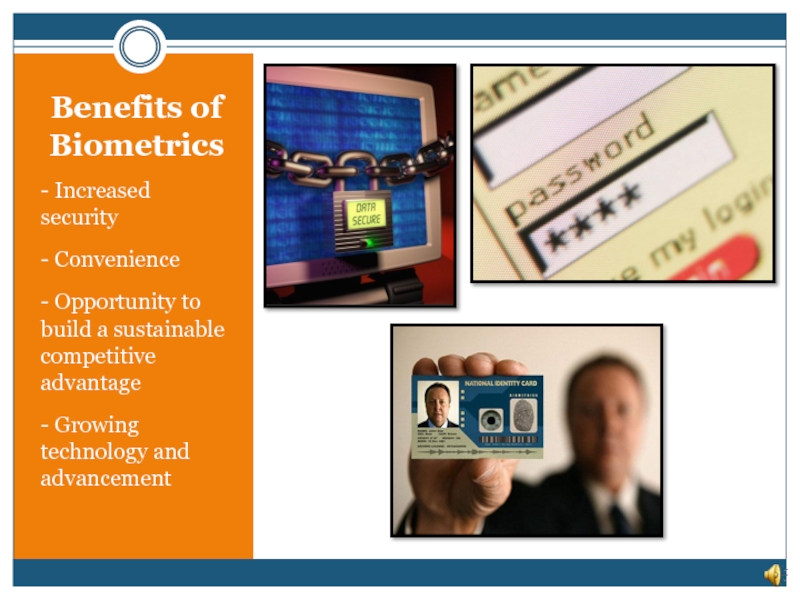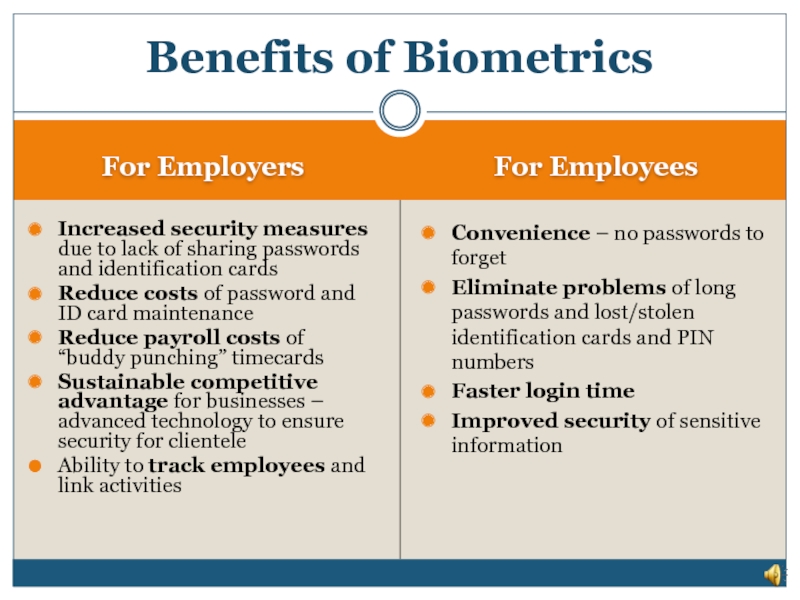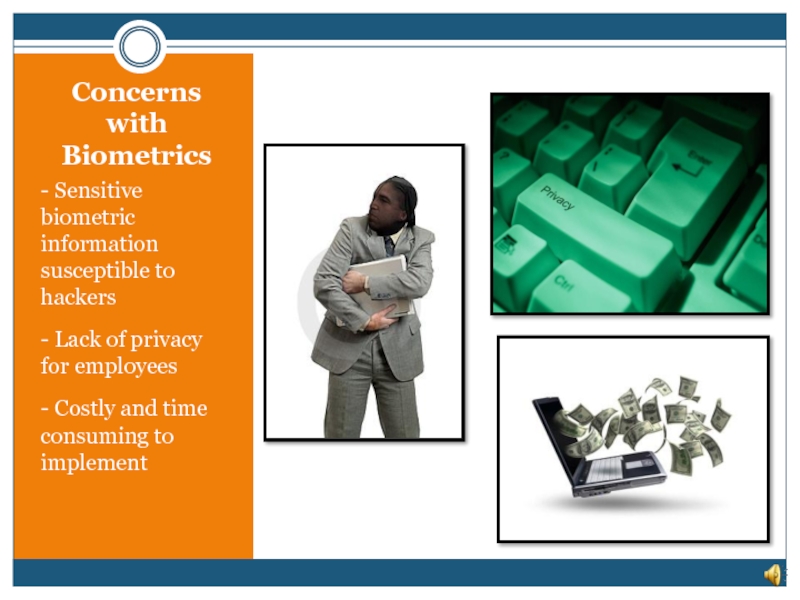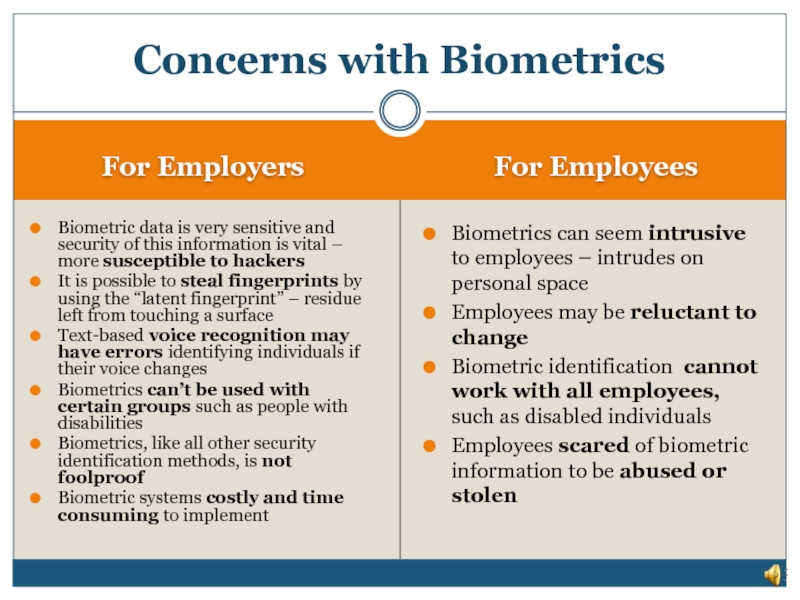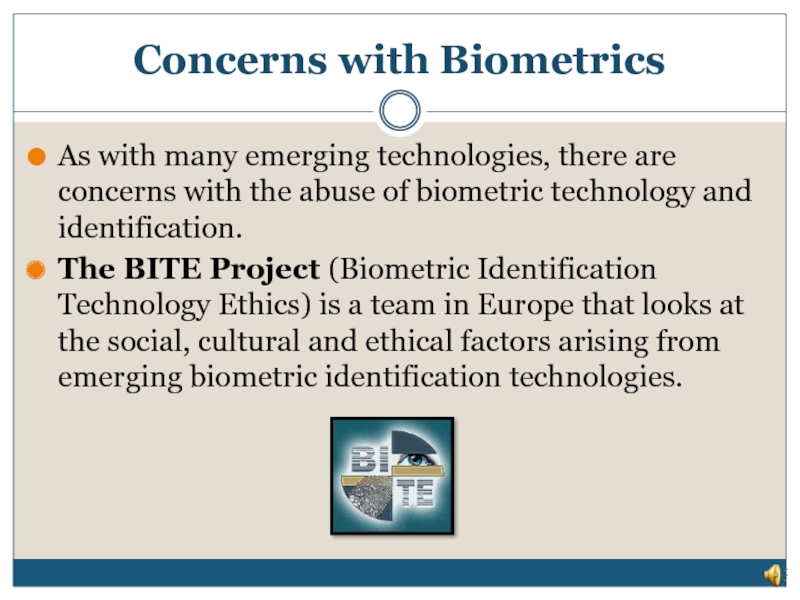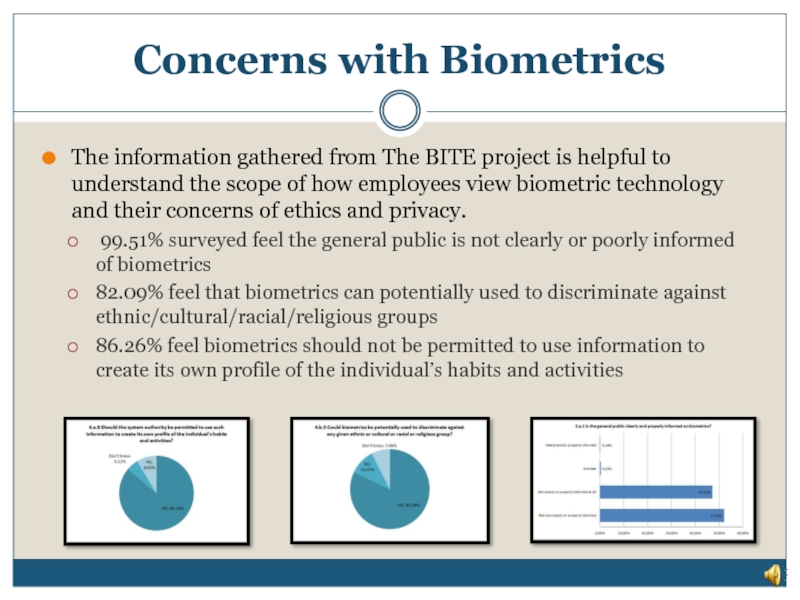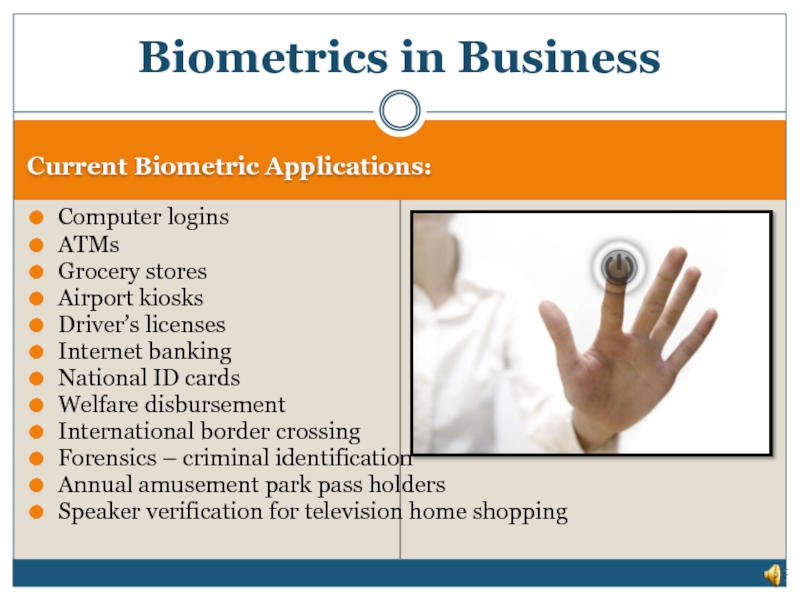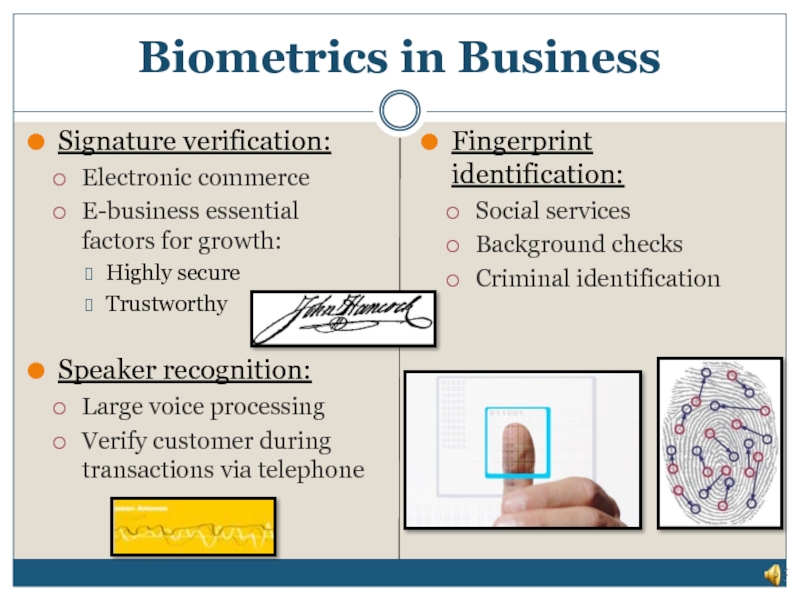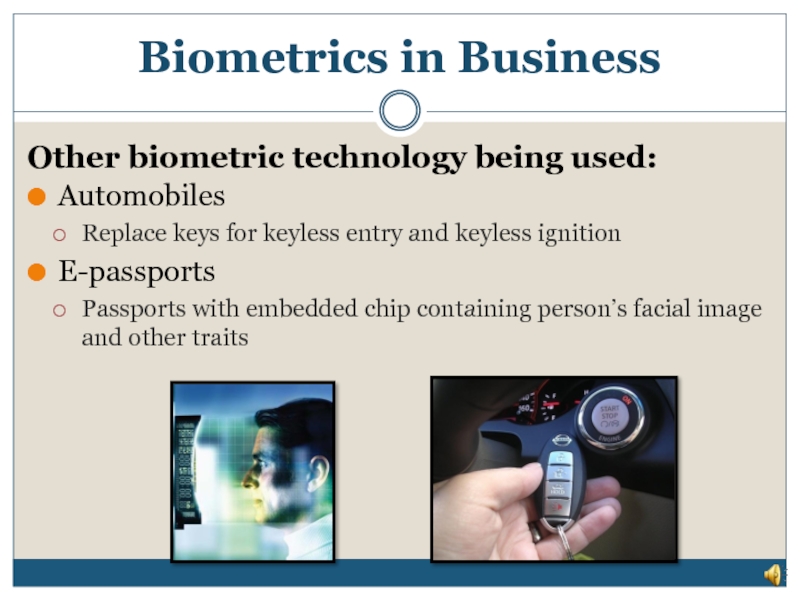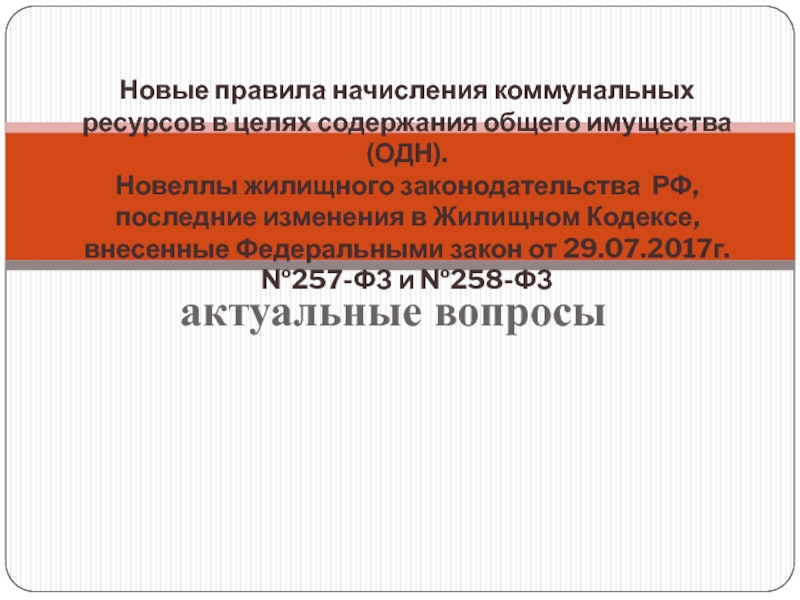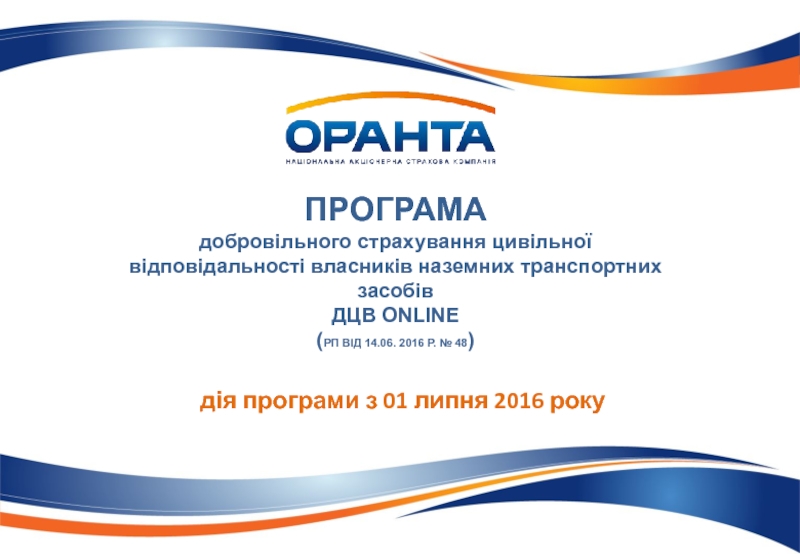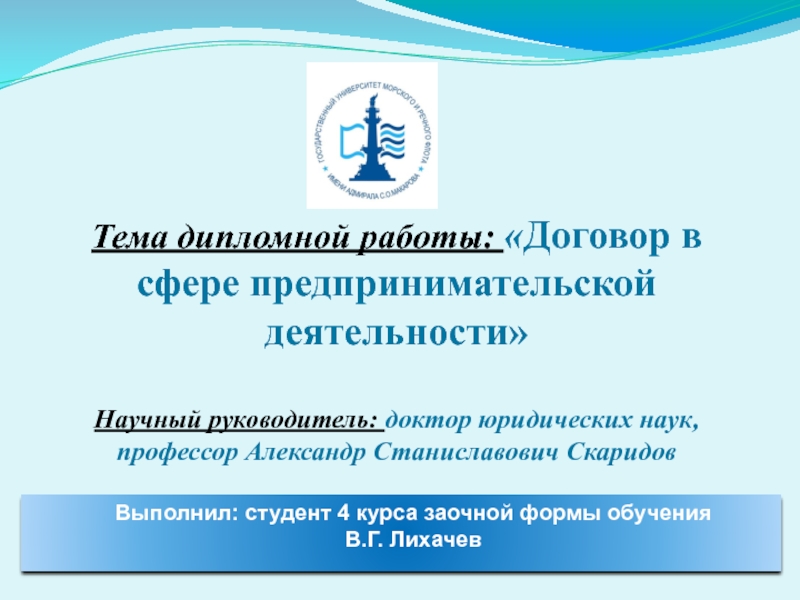- Главная
- Разное
- Дизайн
- Бизнес и предпринимательство
- Аналитика
- Образование
- Развлечения
- Красота и здоровье
- Финансы
- Государство
- Путешествия
- Спорт
- Недвижимость
- Армия
- Графика
- Культурология
- Еда и кулинария
- Лингвистика
- Английский язык
- Астрономия
- Алгебра
- Биология
- География
- Детские презентации
- Информатика
- История
- Литература
- Маркетинг
- Математика
- Медицина
- Менеджмент
- Музыка
- МХК
- Немецкий язык
- ОБЖ
- Обществознание
- Окружающий мир
- Педагогика
- Русский язык
- Технология
- Физика
- Философия
- Химия
- Шаблоны, картинки для презентаций
- Экология
- Экономика
- Юриспруденция
Biometrics Overview презентация
Содержание
- 3. Biometrics
- 4. Biometrics Overview Automated methods of identifying or
- 5. Biometrics Overview Verification Am I who I
- 6. Fingerprint Fingerprint Pattern Analysis Typical System: fingerprint
- 7. The analysis of fingerprints for matching
- 8. The major Minutia features of fingerprint
- 9. Facial Recognition Face characteristics analysis Typical system:
- 10. Facial Recognition : Techniques Traditional Some facial
- 11. Hand Geometry Hand shape analysis and measurement
- 12. Iris Recognition Iris analysis Typical system: scanner
- 13. Visible light reveals rich pigmentation details of
- 14. Retina Scanning Analysis of layer of blood
- 15. The human retina is a thin tissue composed of neural cells that is
- 16. DNA (Deoxyribonucleic acid) A DNA sample is
- 17. Speaker Recognition Voice print analysis Typical system:
- 18. Verification versus Identification There are two major
- 19. Signature Recognition Signature recognition is a behavioural biometric. It
- 20. Comparison Chart Accuracy/Reliability Accuracy: How well can
- 21. What Biometrics are Replacing Passwords PIN numbers
- 22. Benefits of Biometrics - Increased security -
- 23. For Employers For Employees Increased security measures
- 24. Concerns with Biometrics - Sensitive biometric information
- 25. For Employers For Employees Biometric data is
- 26. As with many emerging technologies, there are
- 27. The information gathered from The BITE project
- 28. Biometrics in Business Current Biometric Applications: Computer
- 29. Signature verification: Electronic commerce E-business essential factors
- 30. Automobiles Replace keys for keyless entry and
- 31. Travel and Transport Biometrics is growing in
Слайд 4Biometrics Overview
Automated methods of identifying or verifying the identity of a
What are Biometrics?
Physical:
Fingerprint
Facial Recognition
Hand Geometry
Iris Scan
Retinal Scan
DNA
Behavioral:
Speaker Recognition
Signature Recognition
Слайд 5Biometrics Overview
Verification
Am I who I claim to be?
Identification
Who am I?
Confirm or
NOT what person possesses
ID card
NOT what person remembers
Password
2 ways to recognize a person:
Слайд 6Fingerprint
Fingerprint Pattern Analysis
Typical System: fingerprint scanner maps the series of whorls,
Applications:
Law Enforcement
Entry Devices for Buildings
Computer Network Access
New: grocery stores checkout,
ATM authorization
Softwares used :
C#, VB.Net, VB 6.0 etc
Слайд 7
The analysis of fingerprints for matching purposes generally requires the comparison
Fingerprint : Background
Whorl
Слайд 8
The major Minutia features of fingerprint ridges are: ridge ending, bifurcation, and short
Fingerprint : Background
Ridge Ending
Bifurcation
Short Ridge (Dot)
Слайд 9Facial Recognition
Face characteristics analysis
Typical system: digital video camera input of a
Principle: analysis of the unique shape, pattern and positioning of facial features.
Applications:
Law enforcement
Automated bank tellers- user verification purposes
Слайд 10Facial Recognition : Techniques
Traditional
Some facial recognition algorithms identify facial features by extracting landmarks,
3-D Recognition
This technique uses 3D sensors to capture information about the shape of a face. This information is then used to identify distinctive features on the surface of a face, such as the contour of the eye sockets, nose, and chin.
One advantage of 3D facial recognition is that it is not affected by changes in lighting like other techniques. It can also identify a face from a range of viewing angles.
Skin Texture Analysis
Another emerging trend uses the visual details of the skin, as captured in standard digital or scanned images. This technique, called skin texture analysis, turns the unique lines, patterns, and spots apparent in a person’s skin into a mathematical space. Increases performance by 20 to 25 percent.
Слайд 11Hand Geometry
Hand shape analysis and measurement
Typical system: scanners with guidance pegs
A camera captures an image of the hand, with the help of a mirror to get also the edge. The silhouette/shape of the hand is extracted, and some geometrical characteristics stored.
Applications:
Access Control for Airports
Immigration facilities
Day Care Centers
Time & Attendance Operations
Слайд 12Iris Recognition
Iris analysis
Typical system: scanner analyzes the colored tissue around the
Applications:
Law Enforcement
Employee Security Check
Слайд 13Visible light reveals rich pigmentation details of an Iris by exciting Melanin,
Iris Recognition
Pigmentation of the Iris is much less visible due to the negligible effects of Melanin at longer wavelengths in the NIR spectrum
Visible Wavelength Iris Image
Near Infrared (NIR) version
Слайд 14Retina Scanning
Analysis of layer of blood vessels at the back of
Typical system: low-intensity light source and an optical coupler; the user needs to remove glasses, keep the eye focused on the light, 15 seconds
Applications:
High-end security: military etc.
Used for authentication and identification purposes
Слайд 15The human retina is a thin tissue composed of neural cells that is located in the posterior
A biometric identifier known as a retinal scan is used to map the unique patterns of a person's retina. The blood vessels within the retina absorb light more readily than the surrounding tissue and are easily identified with appropriate lighting. A retinal scan is performed by casting an unperceived beam of low-energy infrared light into a person’s eye as they look through the scanner's eyepiece. This beam of light traces a standardized path on the retina. Because retinal blood vessels are more absorbent of this light than the rest of the eye, the amount of reflection varies during the scan. The pattern of variations is converted to computer code and stored in a database.
Retina Scanning
Слайд 16DNA (Deoxyribonucleic acid)
A DNA sample is used to produce either a
DNA has been called the “ultimate identifier”
Identifies information from every cell in the body in a digital form
Not yet fully automated, not fast and expensive
Applications:
Medical applications
Paternity Tests
Criminal identification and forensics
Commercial applications limited
Слайд 17Speaker Recognition
Voice print analysis
Typical system: uses the pitch, pattern, tone, rhythm
Applications:
Call Centers
Law enforcement – house arrest authentication
Electronic commerce
Customer authentication for service calls
Слайд 18Verification versus Identification
There are two major applications of speaker recognition technologies and methodologies.
Variants of Speaker Recognition
Each speaker recognition system has two phases: Enrollment and verification. During enrollment, the speaker's voice is recorded and typically a number of features are extracted to form a voice print, template, or model. In the verification phase, a speech sample or "utterance" is compared against a previously created voice print. For identification systems, the utterance is compared against multiple voice prints in order to determine the best match(es) while verification systems compare an utterance against a single voice print. Because of the process involved, verification is faster than identification.
Speaker Recognition
Слайд 19Signature Recognition
Signature recognition is a behavioural biometric. It can be operated in two
Static: In this mode, users write their signature on paper, digitize it through an optical scanner or a camera, and the biometric system recognizes the signature analyzing its shape. This group is also known as “off-line”.
Dynamic: In this mode, users write their signature in a digitizing tablet, which acquires the signature in real time. Another possibility is the acquisition by means of stylus-operated PDAs. Dynamic recognition is also known as “on-line”.
Applications
Access to documents
Execution of contracts
Banking services
Слайд 20Comparison Chart Accuracy/Reliability
Accuracy: How well can the specific biometric is able
Reliability: how dependable the specific biometric is for recognition purposes
Слайд 21What Biometrics are Replacing
Passwords
PIN numbers
Tokens
Photo ID cards
Smart cards
Magnetic strip cards
Physical keys
Key
Traditional verification methods:
Слайд 22Benefits of Biometrics
- Increased security
- Convenience
- Opportunity to build a sustainable
- Growing technology and advancement
Слайд 23For Employers
For Employees
Increased security measures due to lack of sharing passwords
Reduce costs of password and ID card maintenance
Reduce payroll costs of “buddy punching” timecards
Sustainable competitive advantage for businesses – advanced technology to ensure security for clientele
Ability to track employees and link activities
Convenience – no passwords to forget
Eliminate problems of long passwords and lost/stolen identification cards and PIN numbers
Faster login time
Improved security of sensitive information
Benefits of Biometrics
Слайд 24Concerns with Biometrics
- Sensitive biometric information susceptible to hackers
- Lack of
- Costly and time consuming to implement
Слайд 25For Employers
For Employees
Biometric data is very sensitive and security of this
It is possible to steal fingerprints by using the “latent fingerprint” – residue left from touching a surface
Text-based voice recognition may have errors identifying individuals if their voice changes
Biometrics can’t be used with certain groups such as people with disabilities
Biometrics, like all other security identification methods, is not foolproof
Biometric systems costly and time consuming to implement
Biometrics can seem intrusive to employees – intrudes on personal space
Employees may be reluctant to change
Biometric identification cannot work with all employees, such as disabled individuals
Employees scared of biometric information to be abused or stolen
Concerns with Biometrics
Слайд 26As with many emerging technologies, there are concerns with the abuse
The BITE Project (Biometric Identification Technology Ethics) is a team in Europe that looks at the social, cultural and ethical factors arising from emerging biometric identification technologies.
Concerns with Biometrics
Слайд 27The information gathered from The BITE project is helpful to understand
99.51% surveyed feel the general public is not clearly or poorly informed of biometrics
82.09% feel that biometrics can potentially used to discriminate against ethnic/cultural/racial/religious groups
86.26% feel biometrics should not be permitted to use information to create its own profile of the individual’s habits and activities
Concerns with Biometrics
Слайд 28Biometrics in Business
Current Biometric Applications:
Computer logins
ATMs
Grocery stores
Airport kiosks
Driver’s licenses
Internet banking
National ID
Welfare disbursement
International border crossing
Forensics – criminal identification
Annual amusement park pass holders
Speaker verification for television home shopping
Слайд 29Signature verification:
Electronic commerce
E-business essential factors for growth:
Highly secure
Trustworthy
Speaker recognition:
Large voice processing
Verify customer during transactions via telephone
Fingerprint identification:
Social services
Background checks
Criminal identification
Biometrics in Business
Слайд 30Automobiles
Replace keys for keyless entry and keyless ignition
E-passports
Passports with embedded chip
Other biometric technology being used:
Biometrics in Business
Слайд 31Travel and Transport
Biometrics is growing in the travel and transportation industry
Examples of how biometrics will be used in the future:
Identification of employees in secure areas at airports, ports
Identification of passengers and monitor of international travel against illegal immigrants
Surveillance of individuals in terminals in regards to criminal activities
Visa control
Biometrics in Business
